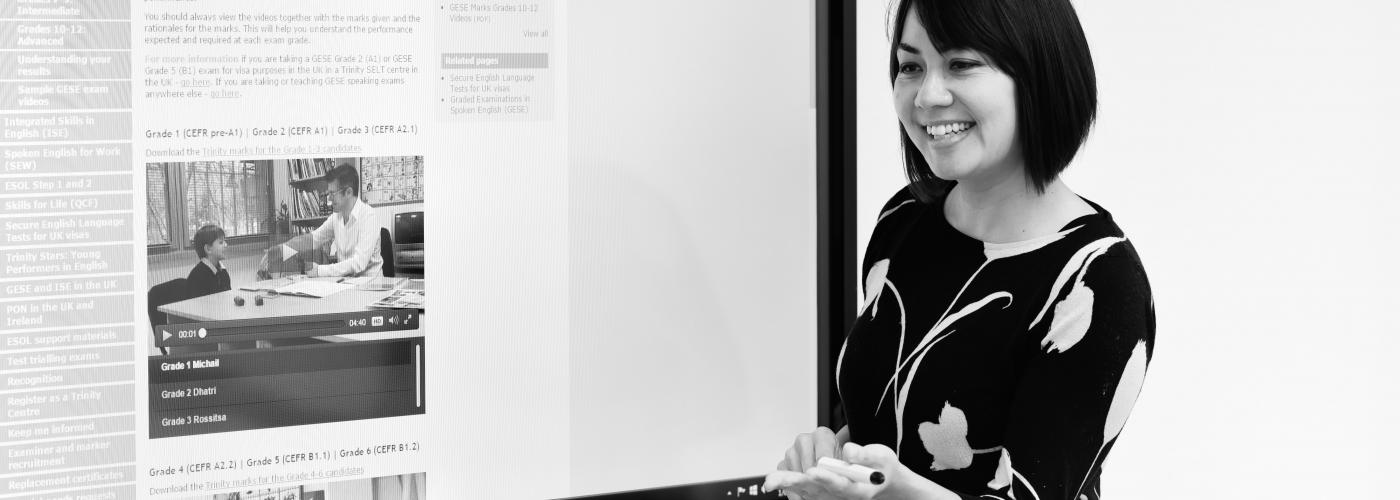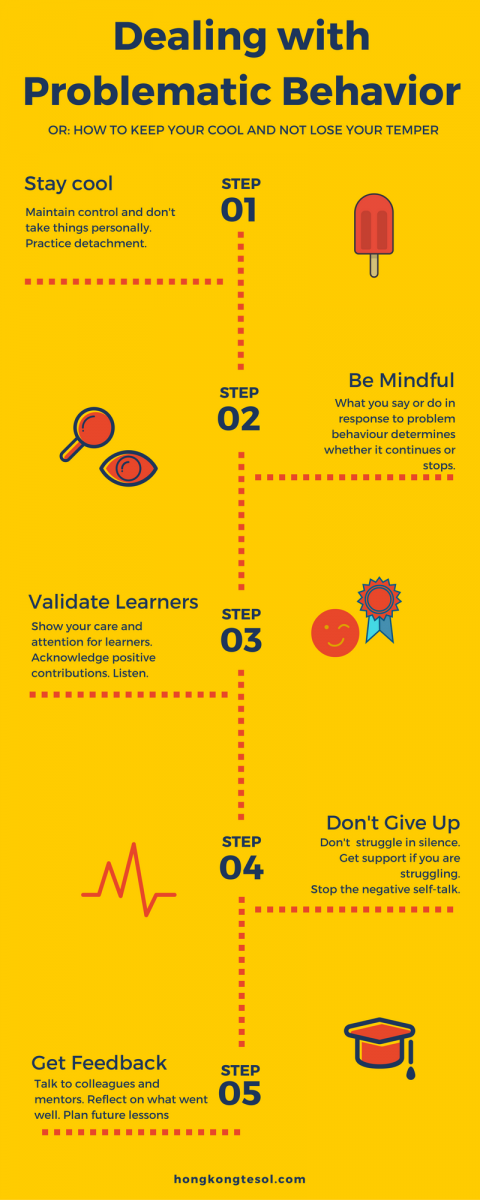1st November 2016
Following on from our earlier article on positive reinforcement, this week I look at how teachers can manage problematic behavior. If you’ve ever had the experience of a difficult student, you are not alone! It’s part and parcel of being a teacher. The only way you could avoid problematic behavior with students would be to only teach one student ever!
When teaching young learners, and sometimes adults, you may often come across situations where the learner’s behavior becomes a problem for the class. Some examples of problem behavior include:
-
Refusal to do any work - creating a power struggle between the teacher and student
-
Chattering – when it becomes a distraction for other students
-
Dependence – when a student becomes so dependent on a teacher that they take up all the teacher’s time and attention
-
Challenging the teacher on every word or task – creating similar power struggles or fights for attention
-
Sulking – when demands for attention are refused or students feel singled out in some way, they become sullen and uncooperative
Sound familiar? So what can teachers do to combat this? Firstly there are a number of techniques for you to consider, about your own teaching methods, before we look at ways to tackle specific behavior.
1. Stay Cool - one of the hardest abilities to master!
While easier said than done, being emotional about a situation will only aggravate negative behavior. When you’re detached, you maintain control by not taking anything personally. Without this ability, learners can be like sharks scenting blood! They can lash out in a knee-jerk reaction which will only escalate a situation. Practising objectivity means you can better defuse challenging behaviour and foster positive behavior.
2. Be Mindful
An essential part of behavior management is to be mindful of your own response. What you say or do in response to a learner’s behavior determines whether they continue or stop what they’re doing. In addition to this, when you are galvanized with effective, positive reinforcement strategies, you’re better able to de-escalate problematic behavior and help learners regain self-control and make better, positive decisions.
3. Validate Your Learners
When learners feel overlooked, sidelined, or not cared for, they often act out and this is particularly true of younger learners. An effective way to counter a learner’s anxiety is to give them attention, acknowledge their contributions and listen to them. Pay attention to what they say, give plenty of personal space. Show through your facial expressions and body language that you’re listening, and you can take away their reasons for being upset. This ability will go a long way in preventing problematic behavior from forming.
4. Don’t Give Up – the other hard one!
Stop the negative self-talk! Very often when learners make you a target of their outburst, remind yourself that you, yourself, are not the cause of the behavior. Being negative will cause you to react negatively. By being detached, you will reduce the amount of negative self-talk and know how to respond positively. Practice positive reinforcement techniques frequently and those negative thoughts will disappear. Just because you are alone in the classroom with your class, doesn't mean that you can handle everything. Knowing where to go and who to turn to in difficult situations to provide support and backup is crucial to staying in control of your own behavior and responding appropriately. At times if problematic behavior is persistent and particularly physical or aggressive, you should notify your principal / senior teacher and keep a record to be able to show parents and specialists. It’s fine to let someone more senior handle difficult situations if you are struggling.
5. Talk to Someone Else
After a difficult situation, talk to someone else – a colleague or a mentor. It can help to relieve stress. Don’t forget to consider what was done well and it will help you plan how to respond better the next time a problem occurs.
When you have a handle on your own strategies, think about specific behavior and what could be done. Going back to our problem behaviors from earlier, here are some suitable strategies that could help:
Challenging the teacher on every word or task
It can be challenging, stressful and sometimes frightening when learners display what can seem like aggressive or psychologically intimidating behavior.
At the end of the day, it's important to keep a few basics in mind when addressing problematic behaviour:
Learn to distinguish what the main issue is
Often what a student says, their tone, body language and general attitude can distract us from the original, often minor infraction, and a situation can escalate quickly because you have to deal with different issues. When this happens, ignore the secondary issue, be polite and detached and offer help. This gives your learner time to process what you say. For example, “Everything alright, Sophie? I see you aren’t ready yet.” Sophie responds angrily with “Yeh well I can’t find my book, can I?”, it’s better to ignore it or respond with “That’s ok, take another minute” or “Why don’t you share with Amy for now? This part’s important.”
Don’t play their game
It can be incredibly difficult to not respond instinctively and overreact when a student is hostile. But this can escalate a conflict. Instead, remain detached, assertive, but polite, and redirect the student to the main issue. There can be no grounds for a superior to call you out on your behavior should word get back of you losing your cool in a spectacular way. Practice detachment and you will avoid this.
Talk to your student
In many situations this is often a far more effective tactic as students often lose their confidence in their problematic behavior when they are not surrounded by peers. While it usually works better to ignore secondary issues in the heat of the moment, ask the students to have a chat with you after class and explain what their behavior sounds and looks like, and how it affects the class and your relationship with them. Do this early on and stop the behavior in its tracks.
Sulking
This is often secondary to the main issue. Do the same as you would with students who challenge your authority. Schedule a private chat after class and explain your point. Let them know in advance to avoid any further problematic behavior and to acknowledge that you will always follow up on such behavior. Stay positive!
Refusal to do any work
This one is a process with the following steps
- Give your learner a choice, with consequences – Speak directly to the student quietly and use the words "choose" or "choice" in your request. This is important because students need to understand that they have control over how they behave. Their behavior is their responsibility. For example, “That’s fine, you can either do it now or choose to do it in recess, because you’ll need this information for tomorrow.”
- Give them time to absorb and process – Allow your students time to respond to any counteractive measures. Physically move away and respond to another student or walk around the room to give the student a chance to absorb what you’ve said, regain composure while they comply with your request. This will avoid a prolonged confrontation.
- Reestablish your relationship – Make sure you acknowledge when a learner has fulfilled your request, with a simple smile or positive comment to restore confidence in the student that rapport isn’t lost, that you aren't holding any resentment and their relationship with you is still secure. If it’s something particularly serious, respond with an offer for attention. A simple “Thanks, I appreciate you listening to me. Shall we look at this together at the end of the lesson and you can give me your thoughts?”
Chattering
Remember to stay focused on being the positive model of behaviour in the class - often this can mean you need to work on the way you use your voice as a control tool.
- Focus on the main issue by knowing how to redirect – Sometimes students who are singled out will display secondary behavior, maybe such as arguing or sulking. Don't focus on these secondary issues. Briefly validate the student's feelings, then quickly focus on the main issue. For example, the student argues that they were talking about the work, teacher responds with "That’s great, but I would like you to speak in English so we can all hear your contributions, thanks."
- Using positive reinforcement, give a reminder and thank them. For example, "James, open your book to page 12, and quiet, thanks!" By focusing on the desired behavior rather than the undesired behavior and being polite, using "thanks" rather than "please," even when correcting, will tell your learners what you expect.
- Try pausing - Try pausing first before giving a positive reminder or instruction so the student has time to focus and process. When learners are misbehaving, call them by name and pause. A longer than expected pause will communicate that they need to focus on you. It often has the added effect of making other learners pause and re-focus as well.
Dependence
- Instructions with gestures - Use hand signals together with instructions for more effective uptake, such as blocking your hand to signal that a student should wait for your attention and acknowledge them with a simple “Hang on, I’ll come to you in a minute.”
- Positive reinforcement through strategic ignoring - Focus on the task, and acknowledge and reinforce students who display the desired behavior, follow rules and ask for help at the right times. For example, ignore the student who interrupts you. When they sit down and wait quietly, then go to them and praise them, thus reinforcing positive behavior.
- Give students choices - Have routines such as “Check with a friend.” Encourage students to help each other before they ask you. If you enjoy technology in the classroom, boost their independence by asking to research and find what they need on classroom computers. Give pairs or tables an allocated amount of time to check their tech before they rely on you.
While problematic behavior can be extremely stressful, remaining calm and using a range of practical techniques and positive reinforcement strategies will keep you sane. Talking to others will alleviate the emotional burden and you may find that you become a source of support to other struggling teachers.
For more info and ideas to incorporate into your teaching, check out our upcoming training sessions for TEFL teachers in Hong Kong.




